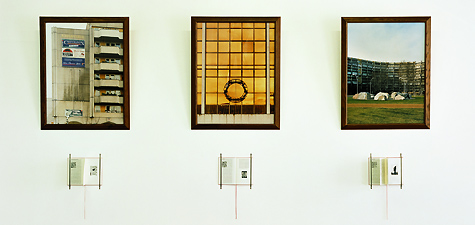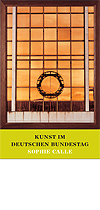Navigationpath: Homepage > Art and History > Art > Artists
Sophie Calle

Three of the twelve colour photographs and books in the Marie-Elisabeth Lüders Building © German Bundestag
Die Entfernung - The Detachment
"To record this process, I visited places from which symbols of GDR history have been effaced. I asked passers-by and residents to describe the objects that once filled these empty spaces. I photographed their absence and replaced the missing monuments with their memories." (Sophie Calle)
Succinctly and precisely, the artist describes the concept behind her installation "Die Entfernung - The Detachment", in which she graphically demonstrates and documents how the reunited city of Berlin comes to terms with its own history, and at the same time raises basic questions about our own existence - for instance how and to what degree we can recall the past, and how memory and personal identity define each other.
Shifts between realistic documentation and fictitious constructs
Such fundamental questions have defined Sophie Calle’s art since its beginnings in the early eighties. The initial focus of her work was her own sense of personal identity, for on returning to Paris after several years of living abroad, she had to rediscover her bearings in the now unfamiliar city of her youth. A candidly voyeuristic project helped to refamiliarise her with what had become an alien environment: camera and notebook in hand, Calle secretly followed a complete stranger through the city streets, construing from her observations everyday stories of Parisian life ambiguously located between fiction and reality. Such shifts between realistic documentation and fictitious constructs also characterise her later work. In "Venetian Suite" (1980), for instance, she pursues a fleeting acquaintance to Venice, observing his movements like a private detective; in "The Hotel" (1981) she gets a job as a chambermaid in a Venetian hotel and rummages through the guests’ suitcases, looking for clues to unfamiliar lives. In another project, "The Shadow" (1981), she has herself followed by a detective engaged by her own mother and afterwards compares notes with him - but only after having him shadowed in his turn by a friend of hers as he carries out his assignment.
Often contradictory observations and descriptions
These projects demonstrate how we attempt to shed light on our own lives by compulsively comparing them with other, unfamiliar biographies. Such confrontations with the way others are - for instance with a Russian on the Trans-Siberian Express ("Anatoli", 1984) - sharpen our sense of the way we ourselves are. Yet it is also clear that any amount of information on other people’s lives does not bring us closer to experiencing their unique individuality. On the contrary, the more information we collect and the closer we believe we are to the individual in question, the more shadowy and intangible the latter’s personality is rendered by our often contradictory observations and descriptions ("The Man with the Address Book", 1983).
Human consciousness of what has disappeared
This is also true of "Die Entfernung - The Detachment". The passers-by’s recollections cannot fill out the empty space in the photograph where the monument once stood, or, for instance, where the GDR state emblem used to hang on the Palace of the Republic (see photograph above). Their recollections are in part so contradictory that the reader begins to doubt whether they are referring to one and the same monument - it has also been "detached" from people’s memories. At the same time, the highly emotional texts testify to the enduring presence in human consciousness of what has disappeared from their world. Sophie Calle’s installation opens our eyes to the complex way in which we perceive reality - and to the equally complex way in which history and the present are interwoven. In this respect, "Die Entfernung - The Detachment" is one of the most revealing artworks on the history of inter-German relations and its contemporary afterimage.
Sophie Calle
born in Paris in 1953, lives in Paris and New York.
Installation: "Die Entfernung - The Detachment",
12 colour photographs and 12 books, 1996,
Marie-Elisabeth Lüders Building, Berlin
Peace-Dove (Nikolaiviertel - Nikolai Quarter)
"There was an inscription. I can’t remember exactly what was written, though I used to walk by the place often. But I’m sure it wasn’t anything very decent." - "It was a big dove, kind of "Picassoesque", with this twig in its beak, about as big as a large room, but I never climbed up there to check." - "Well, it wasn’t made of porcelain, but it must have been something similar. Something very precious. A peace dove is always white, so the peace dove was white. It was probably supposed to express a positive, general attitude. Often such subtle things are more effective than the blatant ones" ... "The line BERLIN, CITY OF PEACE was the heartfelt wish of the head of state. It was selected by him personally, by Erich Honecker, that is. To me, the inscription seemed cynical. Peace reigned in the GDR but it was a graveyard peace. I think it’s a shame that it was removed because it provided a starting-point for discussion."In 1996 passers-by describe from memory a house wall in Berlin’s Nikolai Quarter on which in the GDR era a sculpture of a peace-dove was mounted.
-
Flyer: Sophie Calle (pdf | 773 KB)
Further Information
Information Material
-
Flyer: Sophie Calle


